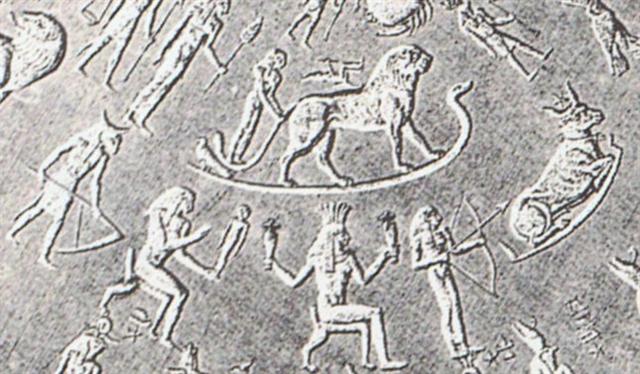|
"Sati (Satet) was one of Khnum's two wives and as such a guardian goddess of the Cataracts. According to Maspero her name signifies 'She who runs like an arrow'. She is the Archer who lets fly the river's current with the force and rapidity of an arrow. She is represented as a woman wearing the white crown of the South, flanked by two long horns. Like Neith she often holds arrows and a bow in her hands. She was worshipped in the extreme south of Egypt, where her favourite abode was the island of Seheil. She gave her name to the first nome of Upper Egypt which was called Ta Setet, the 'Land of Sati'. Its capital was Abu, 'City of the Elephant', the Elephantine of the Greeks, where Sati took her place in the temple of Khnum in company with Anuket. Anuket (Anquet), the Greek for which was Anukis, was Khnum's second wife. She is represented as a woman wearing a tall plumed crown. Her name seems to mean 'the Clasper' - she who clasps the river bank and presses the Nile between the rocks of Philae and Syene. She was worshipped at Elephantine with Khnum and Sati as a regional goddess of the Cataracts. She liked to reside on the island of Seheil, which was consecrated to her." (Larousse) "Khnemu worked with Ptah in carrying out the work of creation ordered by Thot, and is therefore one of the oldest divinities of Egypt; his name means 'to mould', 'to model'. His connexion with the primeval water caused him to be regarded as the chief god of the inundation and lord of the cataract at Elephantine. He dwelt in Annu, but he was lord of Elephantine, and 'the builder of men, the maker of the gods, and the father from the beginning'. Elsewhere he is said to be 'Maker of things which are, creator of what shall be, the beginning of beings, father of fathers, and mother of mothers'. He supported the heaven upon its four pillars in the beginning, and earth, air, sea, and sky are his handiwork. He is depicted in the form of a man having a ram's head and horns surmounted by plumes, uræi with disks, etc.; in one hand he holds the sceptre and in the other the emblem of life. Occasionally he is hawk-headed, and in one representation he holds the emblem of water in each hand. On a late bas-relief at Philæ we find him seated at a potter's table upon which stands a human being whom he has just fashioned." (Book of the Dead) |
|
The first figure in the sequence has a ram's head and presumably he is meant to illustrate Khnum. He 'fashions' the child who is the main figure in next 'glyph'. I guess it is Anuket who holds the child. Presumably she is also the person in the 3rd 'glyph'. The Nile has two banks and the eastern bank should correspond to birth, because the western is associated with death. The two banks thus resemble the two faces of the moon. Satit will then perform the role of the sun. She has only 1 'glyph' and the arrow is an instrument of the sun (his rays). The cow in the sky resides in a kind of boat with 2 ends, but the Lion stands in a vessel with only 1 figure head. It is a snake. The Sothis cow is connected with the moon and the Lion with the sun. |
